Performance and Microstructure of Cold Recycled Mixes Using Asphalt Emulsion with Different Contents of Cement
Abstract
1. Introduction
2. Materials and Methods
2.1. Materials
2.2. Mix Design and Specimen Preparation
2.2.1. Mix Design
2.2.2. Specimen Preparation
2.3. Experimental Methods
2.3.1. High-Temperature Stability Test
2.3.2. Low-Temperature Cracking Resistance Test
2.3.3. Moisture Susceptibility Test
2.3.4. SEM Test and Energy Spectrum Analysis
3. Results and Discussion
3.1. High-Temperature Stability
3.2. Low-Temperature Cracking Resistance
3.3. Moisture Susceptibility
3.4. Microstructure Analysis
3.5. Energy Spectrum Analysis
4. Conclusions
- (1)
- The high-temperature stability of CRME increases rapidly with the contents of cement from 0% to 3%. The moisture susceptibility of CRME increases rapidly with the contents of cement from 0% to 5%. The low-temperature cracking resistance of CRME gradually increased when the cement content is from 0% to 1.5%. However, it gradually decreased when the cement content is from 1.5% to 4%.
- (2)
- The fracture surface and the chemical composition of CRME without cement and with different contents of cement are different by the SEM test and energy spectrum analysis. Hydration products are coated by asphalt emulsion when the content of cement is 1% and 2%. And the composite structure is formed by hydration products and asphalt emulsion.
- (3)
- According to the results of the microstructure and performance tests, the optimum content of cement is suggested to be 1% to 2%.
Author Contributions
Funding
Acknowledgments
Conflicts of Interest
References
- Lin, J.; Hong, J.; Xiao, Y. Dynamic characteristics of 100% cold recycled asphalt mixture using asphalt emulsion and cement. J. Clean. Prod. 2017, 156, 337–344. [Google Scholar] [CrossRef]
- Sangiorgi, C.; Tataranni, P.; Simone, A.; Vignali, V.; Lantieri, C.; Dondi, G. A laboratory and filed evaluation of Cold Recycled Mixture for base layer entirely made with Reclaimed Asphalt Pavement. Constr. Build. Mater. 2017, 138, 232–239. [Google Scholar] [CrossRef]
- Ayar, P. Effects of additives on the mechanical performance in recycled mixtures with bitumen emulsion: An overview. Constr. Build. Mater. 2018, 178, 551–561. [Google Scholar] [CrossRef]
- Tataranni, P.; Sangiorgi, C.; Simone, A.; Vignali, V.; Lantieri, C.; Dondi, G. A laboratory and field study on 100% Recycled Cement Bound Mixture for base layers. Int. J. Pavement Res. Technol. 2018, 11, 427–434. [Google Scholar] [CrossRef]
- Brayton, T.E.; Lee, K.W.; Harington, J.; Kearney, E.J. Construction and Materials Issues. Characterization of cold in-place recycling asphalt mixtures. In Proceedings of the Construction Institute Sessions at the ASCE Civil Engineering Conference, Houston, TX, USA, 10–13 October 2001; pp. 193–205. [Google Scholar]
- Behnood, A.; Gharehveran, M.M.; Asl, F.G.; Ameri, M. Effects of copper slag and recycled concrete aggregate on the properties of CIR mixes with bitumen emulsion, rice husk ash, Portland cement and fly ash. Constr. Build. Mater. 2015, 96, 172–180. [Google Scholar] [CrossRef]
- Tebaldi, G.; Dave, E.V.; Marsac, P.; Muraya, P.; Hugener, M.; Pasetto, M.; Graziani, A.; Grilli, A.; Bocci, M.; Marradi, A.; et al. Synthesis of standards and procedures for specimen preparation and in-field evaluation of cold-recycled asphalt mixtures. Road Mater. Pavement Des. 2014, 15, 272–299. [Google Scholar] [CrossRef]
- Kandhal, P.S.; Mallick, R.B. Pavement Recycling Guidelines for State and Local Governments Participant’s Reference Book (Report No. FHWA-SA-98-042); U.S. Department of Transportation, Federal Highway Administration (FHWA), Office of Engineering/Office of Technology Applications: Washington, DC, USA, 1997.
- Niazi, Y.; Jalili, M. Effect of Portland cement and lime additives on properties of cold in-place recycled mixtures with asphalt emulsion. Constr. Build. Mater. 2009, 23, 1338–1343. [Google Scholar] [CrossRef]
- Hodgkinson, A.; Visser, A.T. The role of fillers and cementitious binders when recycling with foamed bitumen or bitumen emulsion. In Proceedings of the 8th Conference on Asphalt Pavements for Southern Africa (CAPSA’04), Sun City, South Africa, 12–16 September 2004. [Google Scholar]
- Kim, Y.; Lee, H.D. Performance evaluation of Cold In-Place Recycling mixtures using emulsified asphalt based on dynamic modulus, flow number, flow time, and raveling loss. KSCE J. Civ. Eng. 2012, 16, 586–593. [Google Scholar] [CrossRef]
- Godenzoni, C.; Graziani, A.; Bocci, E.; Bocci, M. The evolution of the mechanical behaviour of cold recycled mixtures stabilised with cement and bitumen: Field and laboratory study. Road Mater. Pavement Des. 2018, 19, 856–877. [Google Scholar] [CrossRef]
- Du, S. Performance Characteristic of Cold Recycled Mixture with Asphalt Emulsion and Chemical Additives. Adv. Mater. Sci. Eng. 2015, 2015, 1–8. [Google Scholar] [CrossRef]
- Xu, O.; Wang, Z.; Wang, R. Effects of aggregate gradations and binder contents on engineering properties of cement emulsified asphalt mixtures. Constr. Build. Mater. 2017, 135, 632–640. [Google Scholar] [CrossRef]
- Lin, J.; Wei, T.; Hong, J.; Zhao, Y.; Liu, J. Research on development mechanism of early-stage strength for cold recycled asphalt mixture using emulsion asphalt. Constr. Build. Mater. 2015, 99, 137–142. [Google Scholar] [CrossRef]
- Ojum, C.K. The Design and Optimisation of Cold Asphalt Emulsion Mixtures. Ph.D. Thesis, University of Nottingham, Nottingham, UK, 2015. [Google Scholar]
- Du, S. Effect of different fillers on performance properties of asphalt emulsion mixture. J. Test Eval. 2014, 42, 126–134. [Google Scholar] [CrossRef]
- Modarres, A.; Nejad, F.M.; Kavussi, A.; Hassani, A.; Shabanzadeh, E. A parametric study on the laboratory fatigue characteristics of recycled mixes. Constr. Build. Mater. 2011, 25, 2085–2093. [Google Scholar] [CrossRef]
- Ma, T.; Wang, H.; Zhao, Y.; Huang, X.; Pi, Y. Strength Mechanism and Influence Factors for Cold Recycled Asphalt Mixture. Adv. Mater. Sci. Eng. 2015, 2015, 181853. [Google Scholar] [CrossRef]
- Xiao, J.; Yu, Y. Research on moisture susceptibility of emulsion treated cold reclaimed asphalt mixture. Pav. Mater. 2011, 45–52. [Google Scholar] [CrossRef]
- Kavussi, A.; Nejad, F.M.; Modarres, A. Laboratory fatigue models for recycled mixes with pozzolanic cement and bitumen emulsion. J. Civ. Eng. Manag. 2011, 17, 98–107. [Google Scholar] [CrossRef]
- Modarres, A.; Ayar, P. Comparing the mechanical properties of cold recycled mixture containing coal waste additive and ordinary Portland cement. Int. J. Pavement Eng. 2016, 17, 211–224. [Google Scholar] [CrossRef]
- Dondi, G.; Mazzotta, F.; Sangiorgi, C.; Pettinari, M.; Simone, A.; Vignali, V.; Tataranni, P. Influence of cement and limestone filler on the rheological properties of mastic in cold bituminous recycled mixtures. In Sustainability, Eco-Efficiency, and Conservation in Transportation Infrastructure Asset Management; Informa UK Limited: Colchester, UK, 2014; pp. 61–67. [Google Scholar]
- Recasens, R.M.; Pérez Jiménez, F.E.; Aguilar, S.C. Mixed recycling with emulsion and cement of asphalt pavements. Design procedure and improvements achieved. Mater. Struct. 2000, 33, 324–330. [Google Scholar] [CrossRef]
- Pérez, I.P.; Medina, L.; Del Val, M. Ángel Mechanical properties and behaviour ofin situmaterials which are stabilised with bitumen emulsion. Road Mater. Pavement Des. 2013, 14, 221–238. [Google Scholar] [CrossRef]
- Yan, J.; Leng, Z.; Li, F.; Zhu, H.; Bao, S. Early-age strength and long-term performance of asphalt emulsion cold recycled mixes with various cement contents. Constr. Build. Mater. 2017, 137, 153–159. [Google Scholar] [CrossRef]
- Kavussi, A.; Modarres, A. Laboratory fatigue models for recycled mixes with bitumen emulsion and cement. Constr. Build. Mater. 2010, 24, 1920–1927. [Google Scholar] [CrossRef]
- Wang, Z.J.; An, D.D.; Liu, L.; Wang, H.F.; Zhang, Q. Quantitative evaluation of interfacial adhesion between cement emulsified asphalt mastic and RAP. J. Chang’an Univ. (Nat. Sci. Ed.) 2016, 36, 16–21. [Google Scholar]
- Ministry of Transport of the People’s Republic of China. Technical Specifications for Highway Asphalt Pavement Recycling; JTG F41-2008; China Communications Press: Beijing, China, 2008.
- Ministry of Transport of the People’s Republic of China. Test Methods of Soils for Highway Engineering; JTG E40-2007; China Communications Press: Beijing, China, 2007.
- Ministry of Transport of the People’s Republic of China. Standard Test Methods of Bitumen and Bituminous Mixtures for Highway Engineering; JTG E20-2011; China Communications Press: Beijing, China, 2011.

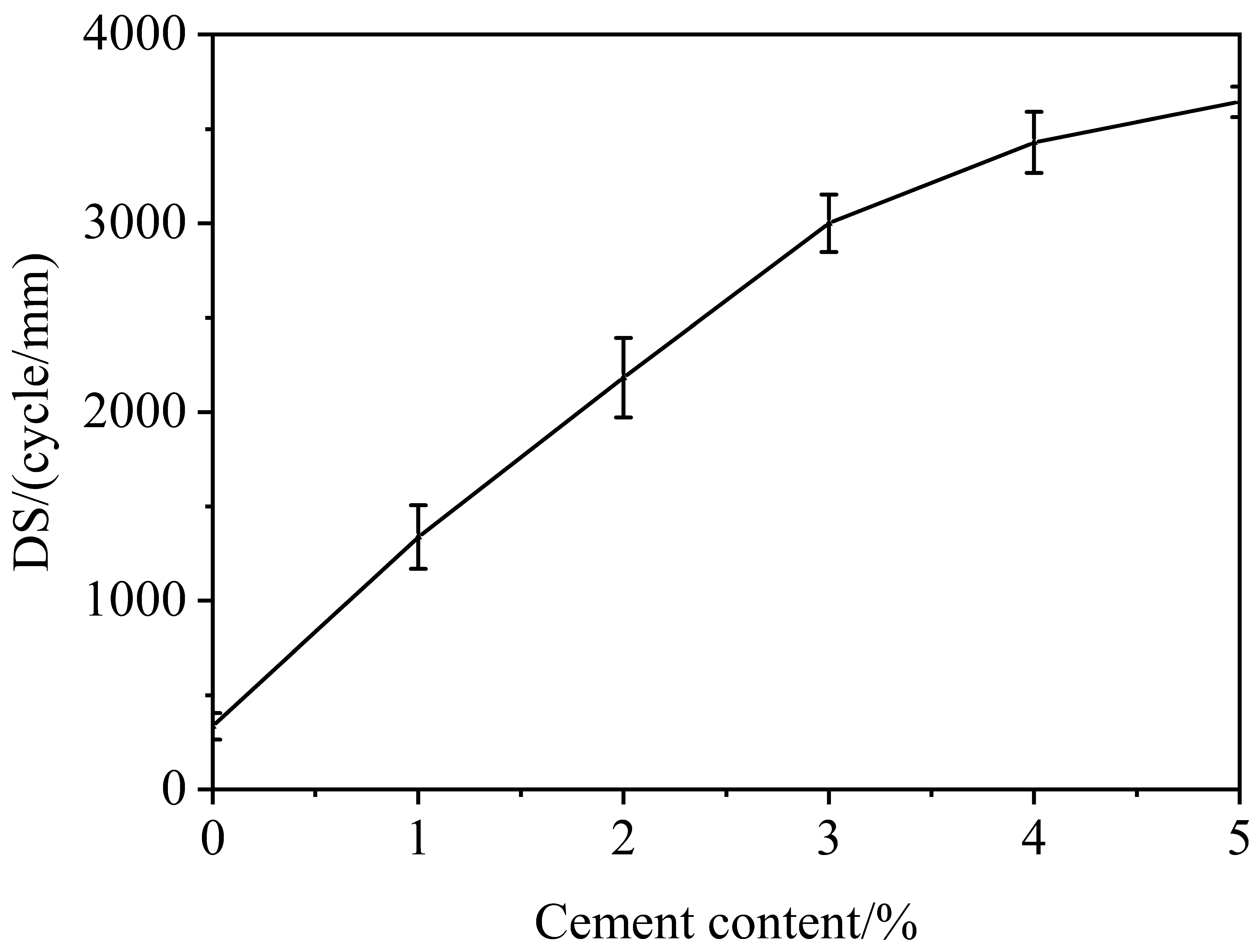
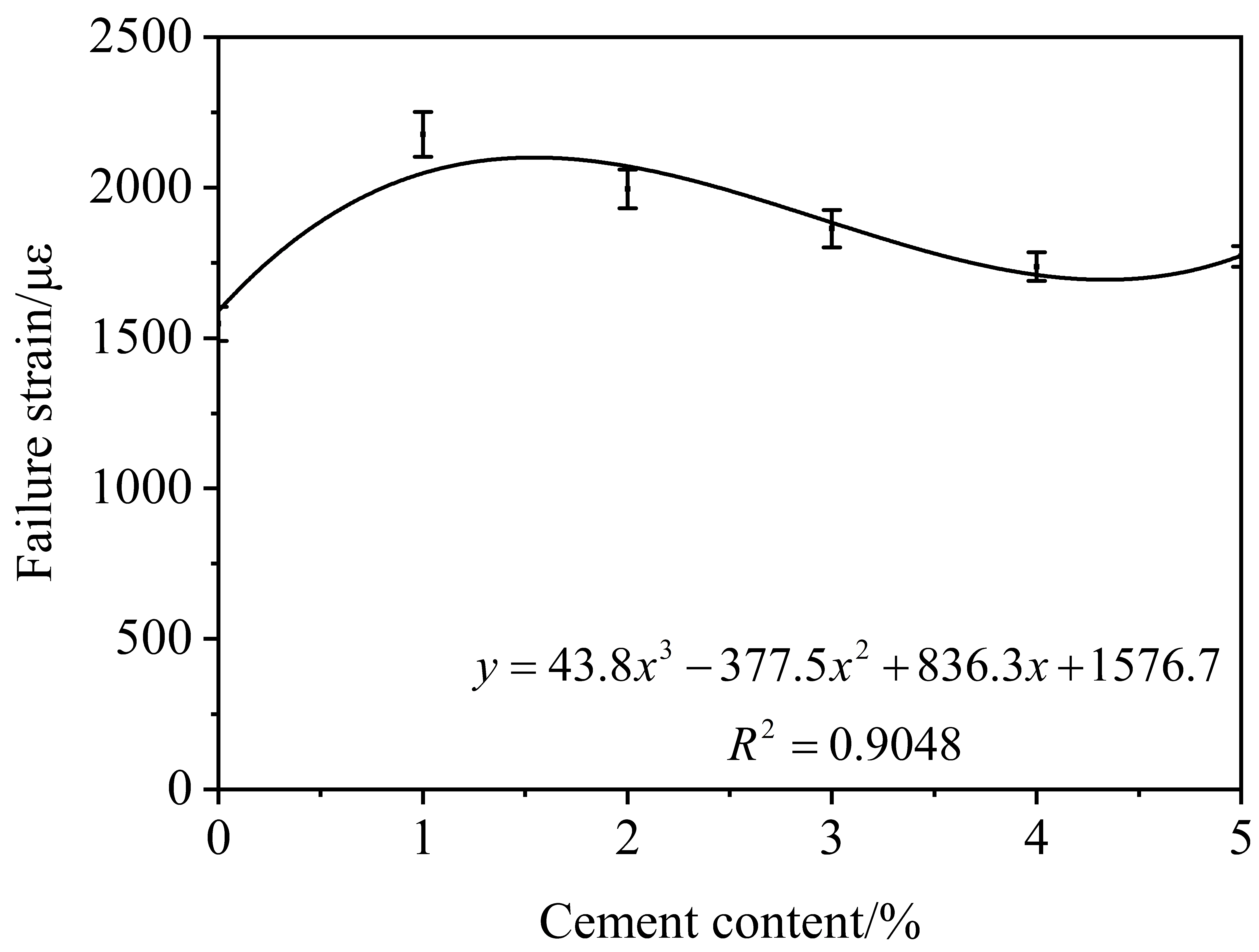
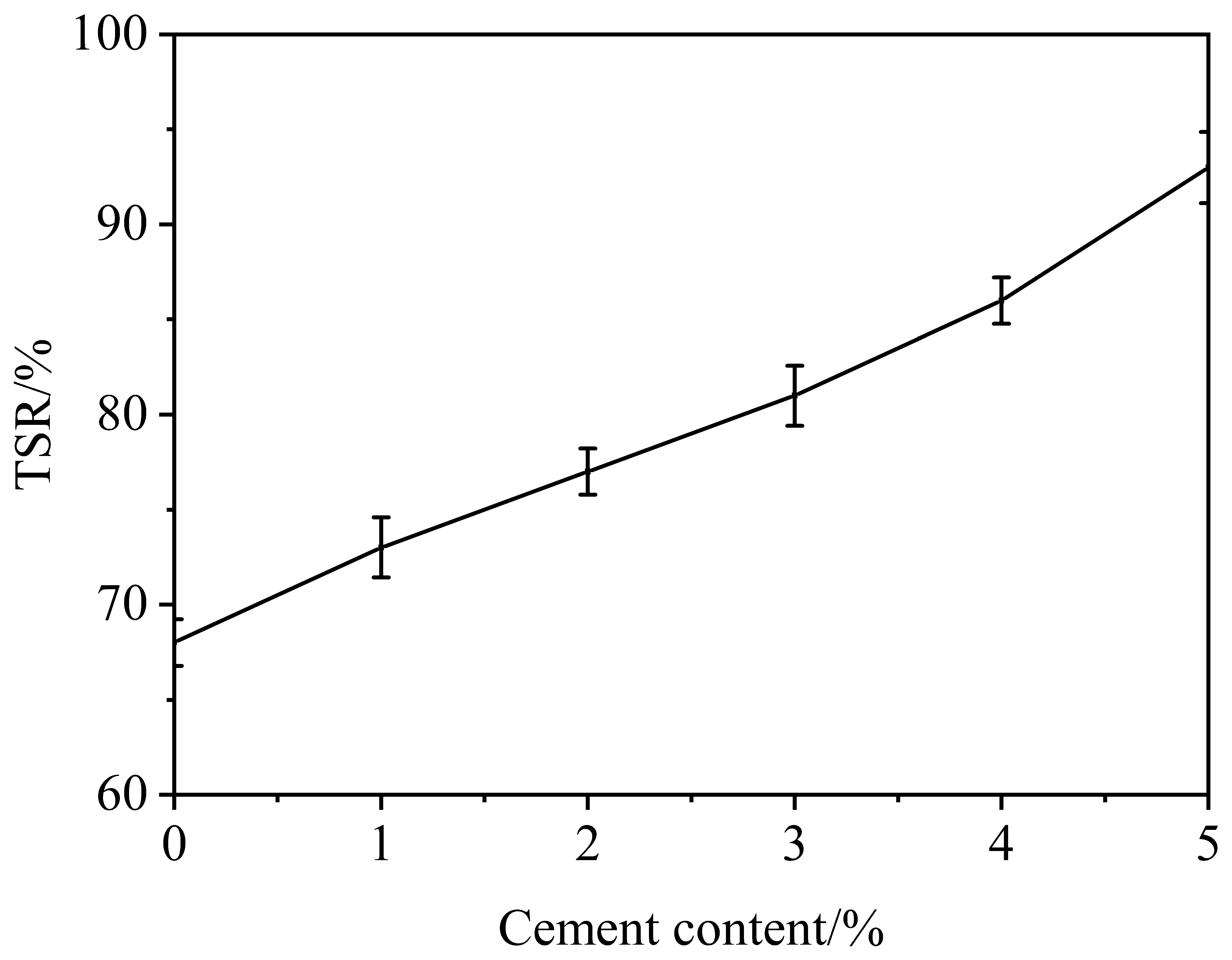
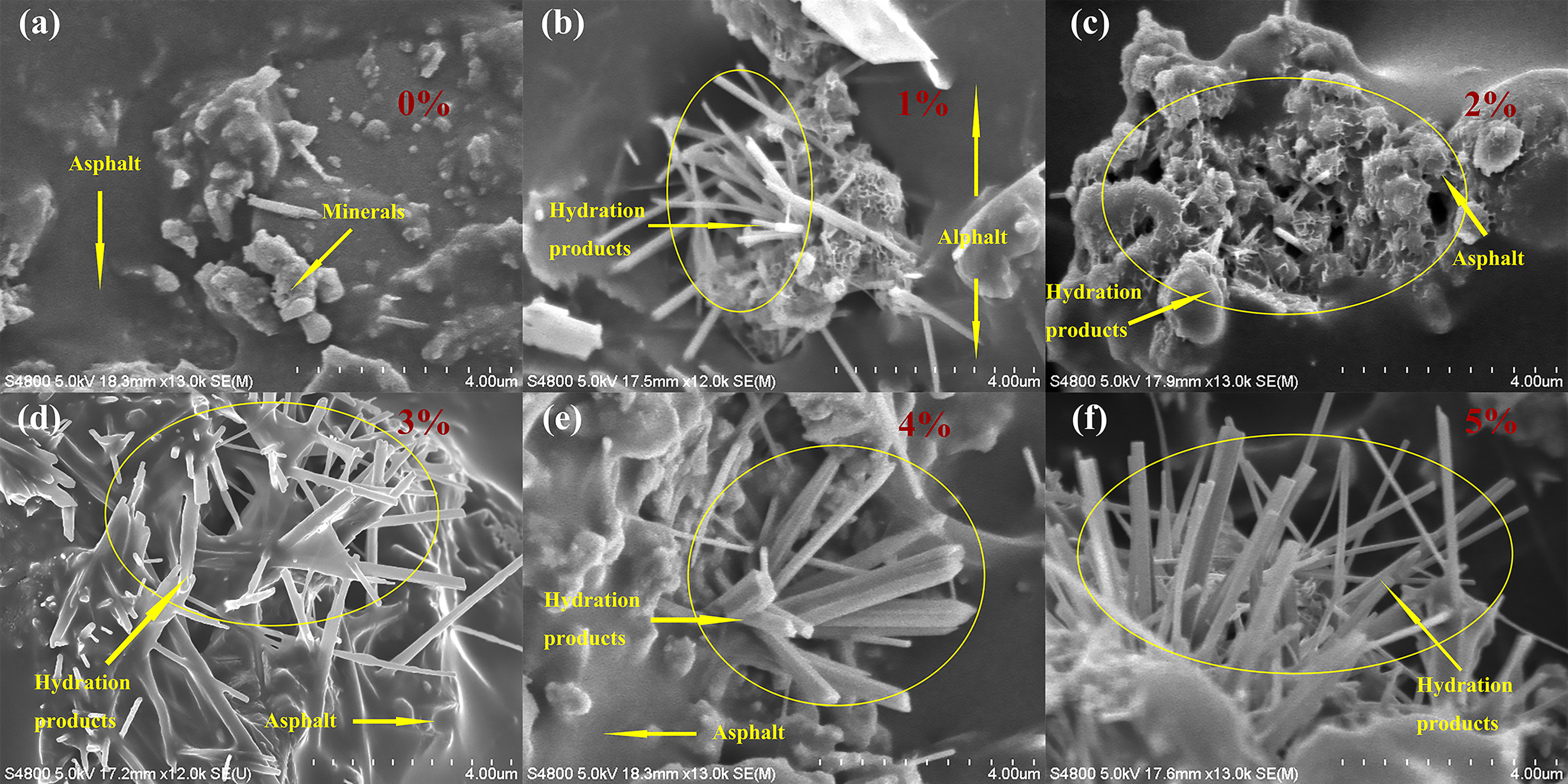
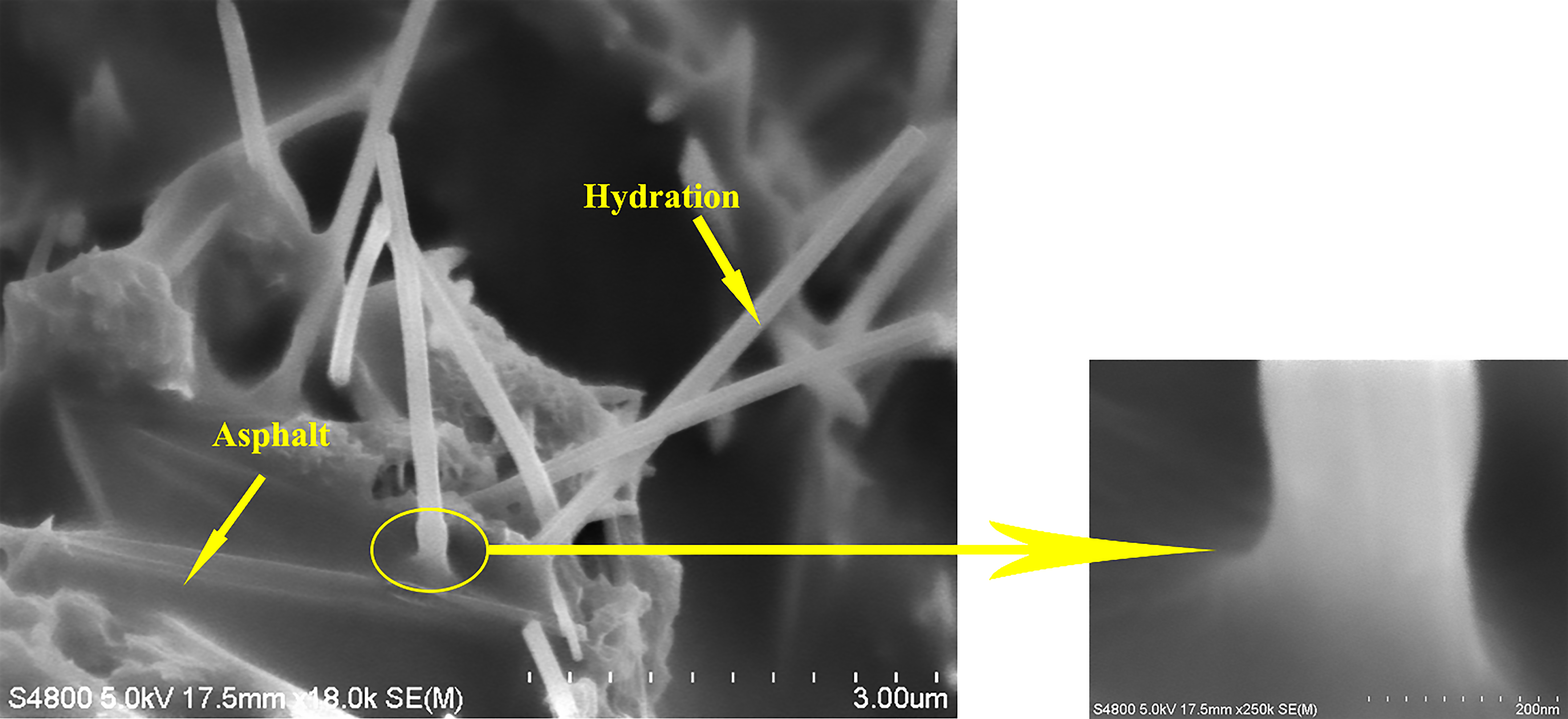
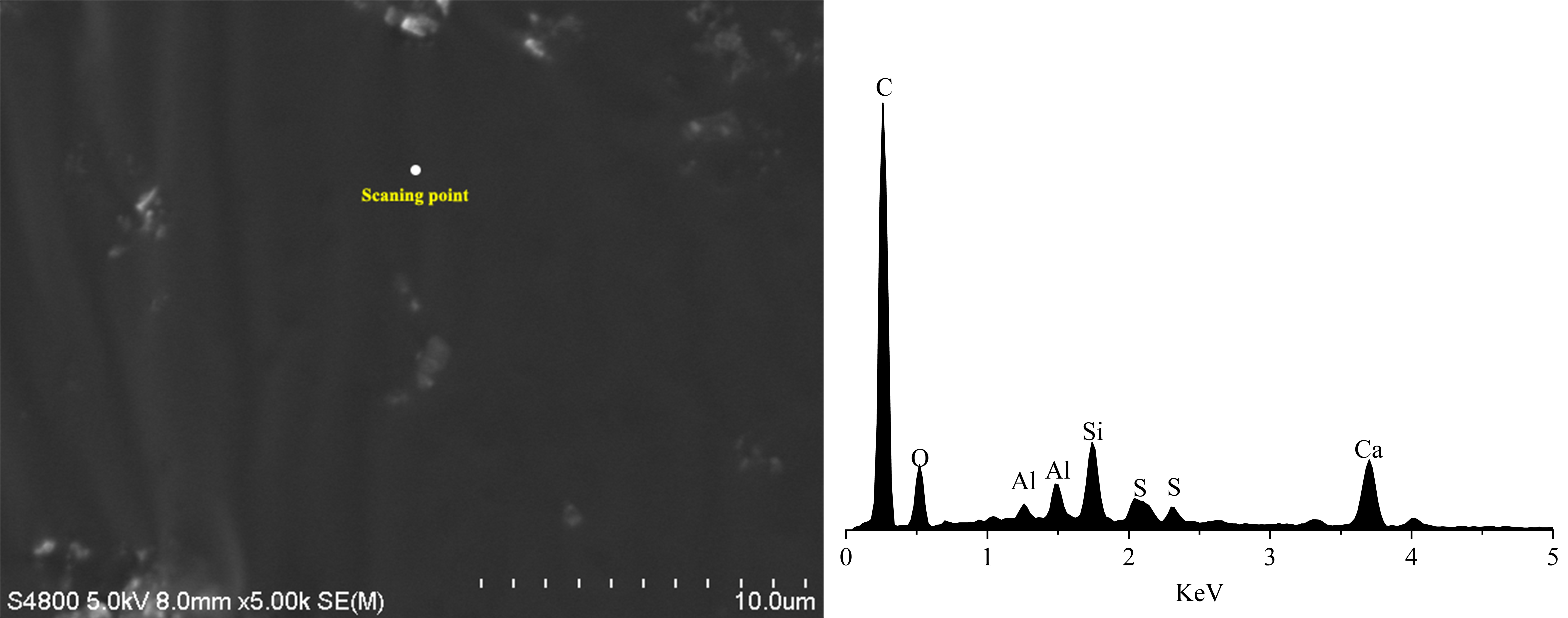
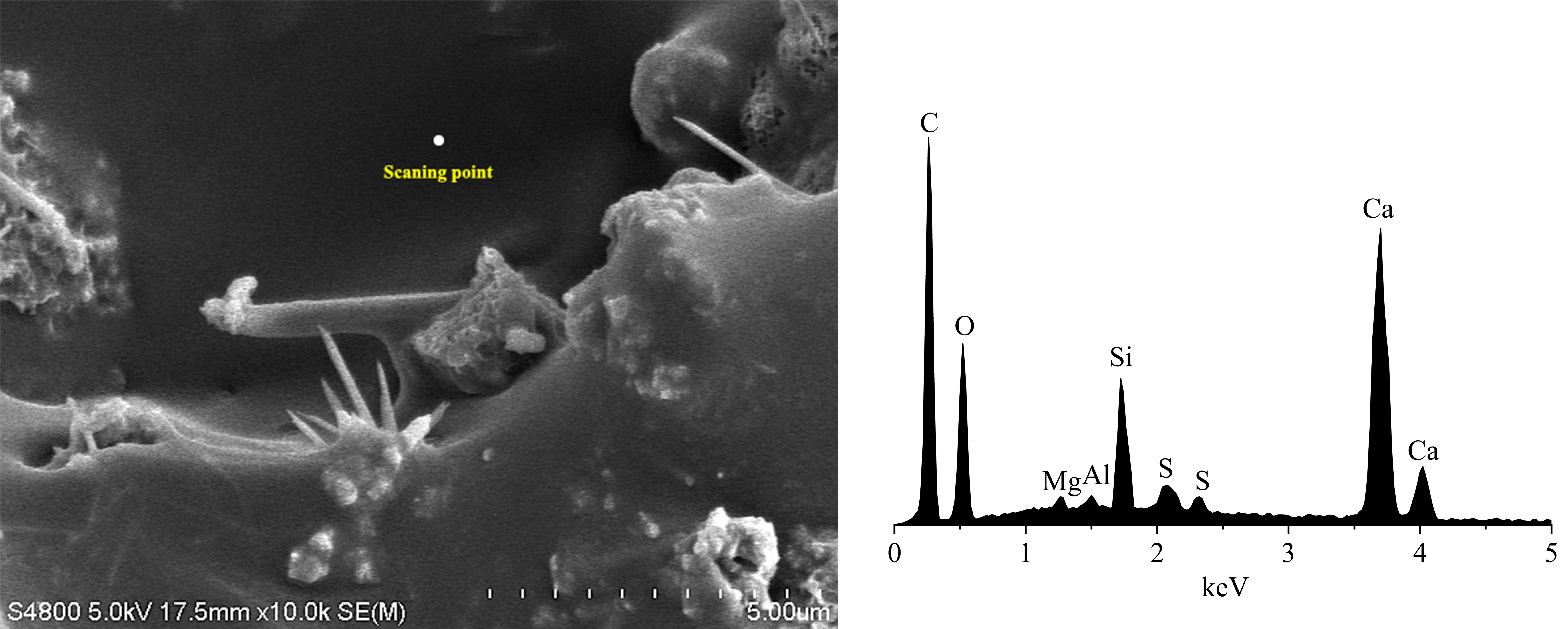
| Property | Test Result |
|---|---|
| Remaining amount on 1.18 mm sieve/wt.% | 0.024 |
| Residue content/wt.% | 64.0 |
| Penetration (25 °C, 100 g)/0.1 mm | 68.1 |
| Softening point/°C | 45.1 |
| Ductility (15 °C)/cm | 76.5 |
| Solubility in trichloroethylene/wt.% | 99.1 |
| Storage stability at 1 d/wt.% | 0.6 |
| Storage stability at 5 d/wt.% | 2.7 |
| Size/mm | 26.5 | 19 | 16 | 13.2 | 9.5 | 4.75 | 2.36 | 1.18 | 0.6 | 0.3 | 0.15 | 0.075 |
|---|---|---|---|---|---|---|---|---|---|---|---|---|
| Passing Rate/% | 100 | 100 | 97.6 | 94.9 | 86.7 | 56.7 | 35.1 | 22.6 | 14.0 | 6.7 | 4.8 | 4.2 |
| Size/mm | 26.5 | 19 | 16 | 13.2 | 9.5 | 4.75 | 2.36 | 1.18 | |
|---|---|---|---|---|---|---|---|---|---|
| Passing rate/% | 16–19 | 100 | 93.1 | 32.5 | 0.5 | ||||
| 13.2–16 | 100 | 99.7 | 85.2 | 32.7 | 1.0 | 0.1 | |||
| 9.5–13.2 | 100 | 100 | 99.7 | 90.5 | 9.0 | 0.2 | |||
| 2.36–4.75 | 100 | 100 | 100 | 100 | 100.0 | 96.7 | 11.3 | 2.6 | |
| Element | C | O | Si | Ca | |
|---|---|---|---|---|---|
| 0% cement | Weight percentage/% | 89.56 | 5.74 | 1.01 | 2.35 |
| Atomic percentage/% | 93.75 | 4.51 | 0.45 | 0.74 | |
| 2% cement | Weight percentage/% | 30.56 | 51.03 | 7.56 | 4.27 |
| Atomic percentage/% | 40.48 | 50.57 | 4.27 | 3.84 | |
© 2019 by the authors. Licensee MDPI, Basel, Switzerland. This article is an open access article distributed under the terms and conditions of the Creative Commons Attribution (CC BY) license (http://creativecommons.org/licenses/by/4.0/).
Share and Cite
Yang, Y.; Yang, Y.; Qian, B. Performance and Microstructure of Cold Recycled Mixes Using Asphalt Emulsion with Different Contents of Cement. Materials 2019, 12, 2548. https://doi.org/10.3390/ma12162548
Yang Y, Yang Y, Qian B. Performance and Microstructure of Cold Recycled Mixes Using Asphalt Emulsion with Different Contents of Cement. Materials. 2019; 12(16):2548. https://doi.org/10.3390/ma12162548
Chicago/Turabian StyleYang, Yanhai, Ye Yang, and Baitong Qian. 2019. "Performance and Microstructure of Cold Recycled Mixes Using Asphalt Emulsion with Different Contents of Cement" Materials 12, no. 16: 2548. https://doi.org/10.3390/ma12162548
APA StyleYang, Y., Yang, Y., & Qian, B. (2019). Performance and Microstructure of Cold Recycled Mixes Using Asphalt Emulsion with Different Contents of Cement. Materials, 12(16), 2548. https://doi.org/10.3390/ma12162548




